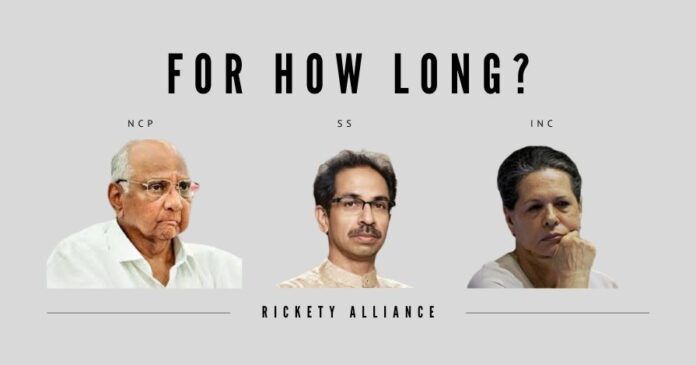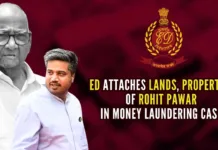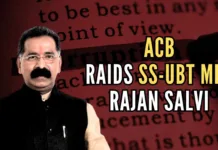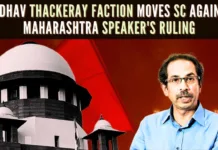
Aesop (620 BC-560 BC) once said that “He that always gives way to others will end in having no principles of his own”.
In the long run in politics, only those who have stuck to their ideology and principles have survived.
In the short run, one may gain power and post by forgetting ideals and basic tenets on which the political party was built but the Public never forgets and forgives.
Neither Mayawati was forgiven for betraying ideals of Kanshiram, nor Akhilesh or Tejaswi Yadav’s were forgotten by the public for throwing ideals of Lohia out the window. Even Rahul Gandhi and Sonia Gandhi were not spared when they had forgotten the ideals of secularism and became pro Muslim in tone, tenor, and in policies; people chose to throw Congress out of power despite having such a big legacy!
Shiv Sena is heading for a similar disaster in the times to come. The instant thirst for power if it is not satisfied then they are heading for a complete wipeout as they have no Ideology left and you cannot have a large number of followers without an Ideology!
History suggests that in most cases, such experiments of coalition have not been successful.
Coalition Governments generally do not succeed in India. It is so for multiple reasons, perhaps — both at the State and the Federal level. This has historically been proved not once or twice but numerous times. The culture of ‘Aya Ram, Gaya Ram’ continues. The unprincipled alliances of various ideologies show that such governments don’t last long and so would be the MahaVikasAghadi Government in Maharashtra. Dwight D. Eisenhower once said, “A people that values its privileges above its principles soon loses both”. One only waits to see, when the Government would fall apart.
Here is a history of a few of the Coalition Governments of unprincipled parties that have miserably failed to stand for a full term.
1977 JANTA PARTY EXPERIMENT
The Janata Party consisted of the Congress (Organisation), the group from whom Prime Minister Indira Gandhi and her supporters broke away in 1969; the Congress for Democracy led by Jagjivan Ram and Hemvati Nandan Bahuguna; the Bharatiya Jan Sangh, which was renamed the Bharatiya Janata Party in 1980; Charan Singh’s Bharatiya Lok Dal, and an assortment of socialists.
At the Centre, the Jan Sangh took to siding with Desai, who felt emboldened to assert himself against Charan Singh and Raj Narain. Citing specious reasons, Desai got the duo to resign on June 30, 1978.
Morarji Desai was elected as the first-ever non-Congress prime minister in the country after the 1977 general elections.
The elections followed the emergency and under the leadership of Morarji Desai, the Janata Party formed the government from 1977 to 1979.
His government could not last for more than two years and Desai resigned in July 1979, after he failed to get a parliamentary majority.
Charan Singh secured the support of Indira Gandhi’s Congress to become Prime Minister. But on August 20, 1979, even before he faced the Lok Sabha, the Congress withdrew support.
The collapse of the Janata Party was to become the opening chapter in the methods the Congress and the Bharatiya Janata Party – the new name given to the Bharatiya Jan Sangh in 1980 – were to adopt to pull down coalition governments in the future.
1989 VP SINGH GOVERNMENT
Preceded by Rajiv Gandhi, VP Singh was India’s eighth prime minister who served from 1989 to 1990. During his prime ministerial tenure, VP Singh is known for his implementation of the Mandal Commission report for India’s backward castes.
His government fell after Singh, along with former Bihar chief minister Lalu Prasad Yadav’s government, had Advani arrested in Samastipur and stopped his Ram RathYatra, which was going to the Babri Masjid site in Ayodhya in October 1990.
BJP withdrew its support to Singh government, causing them to lose a parliamentary vote of confidence on 7th November 1990 by a stunning margin of 356 to 151.
1996 DEVEGOWDA GOVERNMENT
HD Deve Gowda was elected as the 11th prime minister of the country after the 1996 general elections.
The elections had thrown a hung assembly following which the United Front (a conglomeration of non-Congress and non-BJP regional parties) came together to form the government at the centre with the support of the Congress.
Gowda was appointed as the prime minister on June 1, 1996. His government, however, could not survive for a year and Gowda had to step down on April 11, 1997, after the Congress withdrew support from the party.
1997 IK GUJRAL GOVERNMENT
Inder Kumar Gujral served as the 12th Prime Minister of India from April 1997 to March 1998.
The United Front alliance, earlier led by Gowda, formed a new government with the support of Congress under the leadership of IK Gujral.
The members of the CWC passed a resolution thanking Kesri for his leadership as also relinquishing the office of party president in Sonia Gandhi’s favour.
The Congress under the late Sitaram Kesri pulled down I K Gujral’s United Front government in 1997 for his refusal to drop the DMK from his cabinet because of Kesri’s personal ambition to become Prime Minister.
MULAYAM and MAYAWATI
For the first time, the BJP had dominated the politics of UP after the Babri Masjid demolition in 1992. The ‘mandir’ (the Ram Janmabhumi movement) had overshadowed the ‘Mandal’ (the lower caste solidarity in the wake of the Mandal Commission job quota implementation by the VP Singh government). In the 1993 assembly elections in UP, the BJP got the maximum seats, 177, riding on the mandir wave.
But Mulayam and BSP founder Kanshi Ram decided to forge a historic alliance to tackle the resurgent BJP and to keep the saffron party out of power. BSP, under Kanshi Ram’s protégé Mayawati, contested 164 seats and won 67 while SP won 109 out of 256 seats contested in the house of 425 in undivided UP. The coalition formed the government with Congress’s support from the outside. But the tie-up could not sustain beyond two years.
The two parties parted ways within two years, with Mayawati accusing SP of usurping its vote base. On the midnight of June 2, 1995, SP workers besieged the state guest house in Lucknow where Mayawati, having broken off the alliance with Mulayam, was meeting with her party members to forge future strategy.
The very next day, 39-year-old Mayawati was sworn in as chief minister, with BJP’s support. It was the first time she would become CM. It was also the first time Uttar Pradesh would get a Dalit CM.
NITISH KUMAR LALU PRASAD YADAV AND CONGRESS IN BIHAR
Mahagathbandhan (Grand Alliance) was a coalition of political parties in the Eastern state of Bihar in India, formed before the 2015 Vidhan Sabha elections in Bihar.
The alliance consisted of Janata Dal (United), Rashtriya Janata Dal, and Congress parties won the majority of the seats and formed the government in the state. On 26 July 2017, Nitish Kumar broke the alliance and resigned from the Chief Minister post. On 20 December 2018 RLSP joined Mahagathbandhan
It was a political earthquake with Patna as its epicenter, when Nitish Kumar tendered his resignation as the Bihar chief minister, after a tumultuous deadlock over corruption allegations against deputy chief minister Tejashwi Yadav.
Citing his “pricked conscience”, Nitish Kumar decided to step down.
Evidently, Nitish’s resignation came after days of political turmoil under the shadow of corruption charges against several members of Lalu Yadav’s family, particularly deputy chief minister Tejashwi Yadav.
Little wonder then that the RJD had bagged 80 Assembly seats in the 2015 Bihar polls, the highest of all, followed by JDU, which received 71 seats.
However, Nitish’s claustrophobia within the Grand Alliance was becoming increasingly evident as Lalu Yadav’s stronghold on the liaison became greater every day. By resigning as chief minister, Nitish effectively pulled the rug out of the Mahagathbandhan’s feet.
CONGRESS-JDS ALLIANCE AND BJP-JDS ALLIANCE IN KARNATAKA
When former Prime Minister HD Deve Gowda led a faction of the erstwhile Janata Dal and formed the Janata Dal (Secular) in 1999, he declared that his party would forever maintain equidistance from both the Congress and the Bharatiya Janata Party. In the strange twists and turns that politics in this southern state witnessed since then, the JD(S) dumped the principle of equidistance.
The party, which calls itself secular, owes its existence primarily to the unstinted support it enjoys from a single caste group – the Vokkaligas. Deve Gowda is to the Vokkaligas what BS Yeddyurappa became to the Lingayats much later. None of the Vokkaliga leaders in the Congress or the BJP could shake Deve Gowda’s place in the caste groups’ collective consciousness as their supreme political representative.
In reality, however, it is a political venture built, owned, and operated entirely by the Deve Gowda family, with its strongholds confined to three to five districts of southern Karnataka, and drawing its sustenance from a single caste. The third generation of the family, grandsons of Deve Gowda, is already active in the party.
In the first election that it contested in 1999, JD(S) won only 10 seats. Just when everyone started dismissing it as ‘insignificant’, it sprung a surprise by winning 59 seats in the 2004 election. Strangely, this was the election in which a popular Vokkaliga chief minister from the Congress, SM Krishna, made a strong bid for a second term in office, riding on the claims of good governance.
Sensing the prospect of Krishna’s emergence as an alternative leader of Vokkaligas, Deve Gowda mounted a scathing attack on Krishna’s alleged urban-centric policies and punctured holes in his “good governance” claims. Gowda’s efforts yielded results. No party got a majority in that election.
The Congress, led by Krishna, came second after the BJP. The JD(S) became the kingmaker and entered into an alliance with the Congress to form the first-ever coalition government in Karnataka.
When this government, headed at the time by Congress chief minister Dharam Singh, completed 20 months, the JD(S) faced a family coup. Keeping his father in the dark, Kumaraswamy led a group of JD(S) MLAs to withdraw support to the Dharam Singh government. The Kumaraswamy faction entered into a new alliance with the BJP, which was waiting in the wings, nursing the grouse that it could not form the government despite having been the single largest party. Kumaraswamy became the chief minister and Yeddyurappa, a Lingayat, the deputy chief minister. This was the first instance of the BJP tasting power in the south of the Vindhyas. Deve Gowda had initially sulked over his son joining hands with the BJP, sacrificing the secular credentials of the party. But later, Deve Gowda accepted his son’s justification that he had to do this to save the party from the Congress’ designs to destroy it by poaching its MLAs. Under the alliance, the JD(S) was to give the chief minister’s post to Yeddyurappa after 20 months. However, when it was time to pass the baton, Kumaraswamy, under pressure from Deve Gowda, refused to honour the agreement, leading to the imposition of the President’s Rule.
Break-Up Party
The JD(S) also contributed to the revival of the Congress, which was rudderless after SM Krishna moved to the sidelines having failed to get re-elected in 2004. In the Congress-JD(S) coalition government led by Dharam Singh, the JD(S) made Siddaramaiah the deputy chief minister. Siddaramaiah was unhappy that Deve Gowda did not bargain enough with the Congress to make him the chief minister.
This discontent grew into a rift between Siddaramaiah and Deve Gowda. Siddaramaiah felt that he was not getting his due in the Vokkaliga-dominated party. This was the beginning of his now-famous ‘Ahinda politics.’ A miffed Gowda got Siddaramaiah removed from the deputy chief minister’s post, which eventually led to his exit from the JD(S) to join the Congress. A slew of JD(S) leaders close to Siddaramaiah followed suit.
When Kumaraswamy joined hands with the BJP, another senior leader, MP Prakash, a respected Veerashaiva-Lingayat leader, quit the JD(S) and joined the Congress. In the process, as the JD(S) leadership was reduced to Deve Gowda and his family members, the Congress got strengthened with a steady influx of leaders from the JD(S).
This group of turncoats, led by Siddaramaiah, virtually controlled the party until Siddaramaiah stepped down earlier this month. Among the original Congressmen, hardly anyone was a recognisable leader except for DK Shivakumar who could not challenge ex-JD(S) faction in the party as he had his own legal battles to fight to protect his wealth.
Now, the JD(S) has joined hands with the Congress once again in the latter’s hour of crisis. Unlike the last Congress-JD(S) coalition, the JD(S), with just 38 seats has got the chief minister’s position, and the Congress with more than twice the number of JD(S)’s seats is forced to play second fiddle. The influence of the ex-JD(S) faction within the Congress has now faded and the original congress group has taken the center-stage.
MAHA VIKAS AGHADI GOVERNMENT IN MAHARASHTRA.
“Too many cooks spoil the broth”. Maharashtra’s current politics, which looks nothing less than an unlikely alliance stitched together to form the ‘MahaVikasAghadi’ government.
The Shiv-Sena, NCP, and Congress are three distinct parties with an altogether different ideology. The Government was formed after many rounds of deliberations. The greed of power is the reason for the present government. The portfolio was decided after a series of meetings for ironing out differences over the allocation of portfolios. There have been differences from the very initial and having instability as its core, the government is bound to fall down.
The present situation suggests that the Government would not last long. The Congress has already started siding themselves from the coalition. Rahul Gandhi recently said that Congress is only a supporting Party and not a key player in Maharashtra and therefore, they should not be blamed for the present situation. Shiv Sena which had been in alliance with the BJP, is to be seen, as to when would it break the alliance which looks heavily probable.
What Frank Herbert once said still holds water, “All governments suffer a recurring problem: Power attracts pathological personalities. It is not that power corrupts but that it is magnetic to the corruptible.”
History suggests that unprincipled alliances of various ideologies made in the present have failed in every aspect. A coalition government has instability as its core. The National average of such unprincipled alliances does not seem to even touch a year. Many of the coalitions could not even last for a month’s time. Alarm bells are already ringing for the MahaVikasAghadi government in Maharashtra. Only time will tell, how long can this government continue.
Franklin D. Roosevelt once said, “One cannot always build the future for our youth, but we can build our youth for the future”.
All three parties in Maharashtra have shunned their ideology and principles. Congress which claims to be secularist is with Shiv Sena which has many times raised questions over Muslims in their Saamna editorial, be it be compulsorily sterilization of Muslims or throwing out Muslims from Pakistan and Bangladesh residing in India. Shiv Sena under the reign of Sh. Bal Thackeray had also rejected an alliance with NCP, abusing the NCP leader. NCP which has openly abused Congress and Shiv Sena many times in the past, however for the greed of power, is now with them.
Now time is running out fast and soon surprises are in the offing.
- Prime Minister Narendra Modi: A Gujju businessman who does not invest his precious time for a losing battle - April 13, 2024
- NIA arrests two accused Shazib and Taahaa in Bengaluru’s Rameshwaram Cafe blast case from Kolkata - April 12, 2024
- National Herald scam: Adjudicating Authority upholds Rs.752 crore assets attached by ED - April 11, 2024











[…] खबर को अंग्रेजी में यहाँ […]
Was Modi’s act of waking up President of India at 547 AM to lift president’s rule in Maharastra under rule 12 of Transaction of Business (emergency power of PM exercised only during emergency of 1975) to swear-in Ajith Pawar as Deputy CM principled (post-poll knee jerk alliance to do creeping acquisition of MLAs from NCP) ? Was grabbing power in Goa and N-E states without even being the single largest party principled? Buying MLAs by paying illegal money to the tune of Rs.25-30 Cr and housing MLAs in expensive resorts to topple democratically elected governments and making a mockery of the Anti-Defection Law principled? The BJP has done it all. BJP and its supporter have no right to talk about principles. I don’t understand how pgurus team can come up with articles such as these.
The Shiv Sena is a lumpen organisation. Corrupt to the core. The BJP needs to work hard and ween away the saner elements in that party and, if that is difficult,split it.. BJP can come back to power without the Sena if it plays its cards well and woos the electorate with deft propaganda.
It is high time for BJP and Shiv Sena to patch their differences and egos for the betterment of Maharashtra. For this Modi-Shah-Uddhav have to sit together. All should shed their king size egos and must get out from the clutches of Sharad Pawar, the most crooked man in Indian politics in the interest of Nation.
Sharad Pawar was awarded Padma Vibhushan by the Modi government in 2017. How come? BJP and Modi are overrated. All they are doing is Old wine in New bottle.